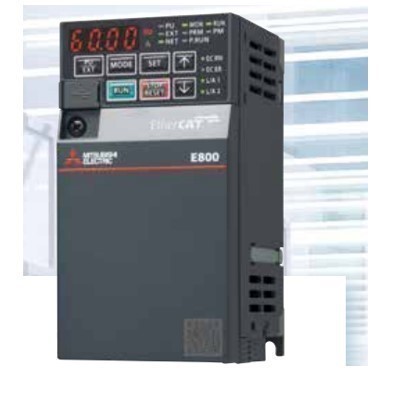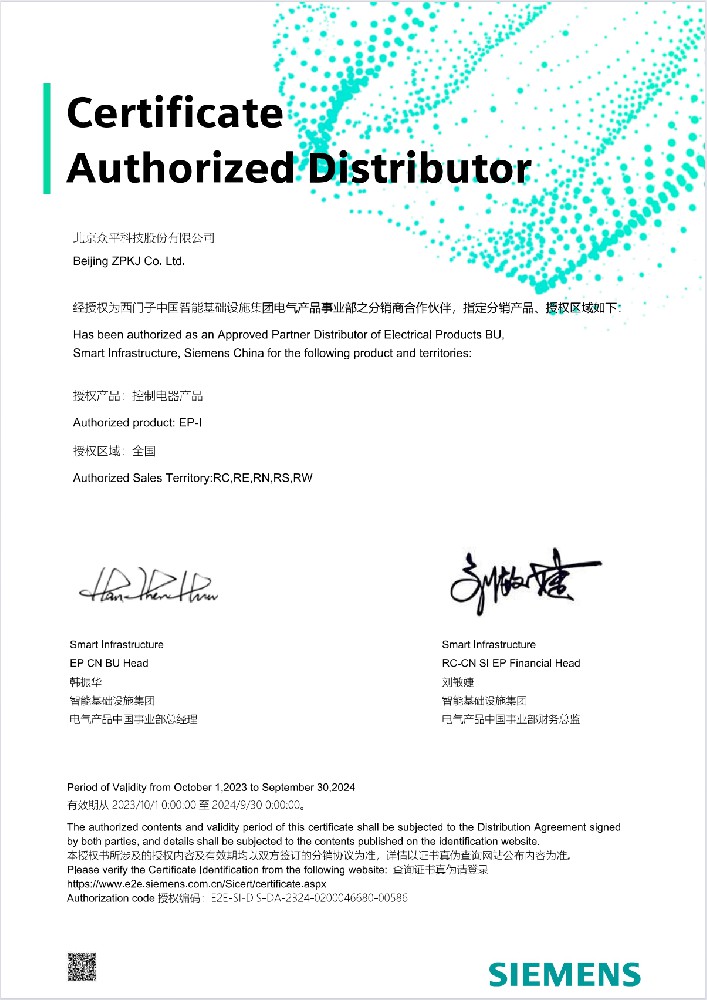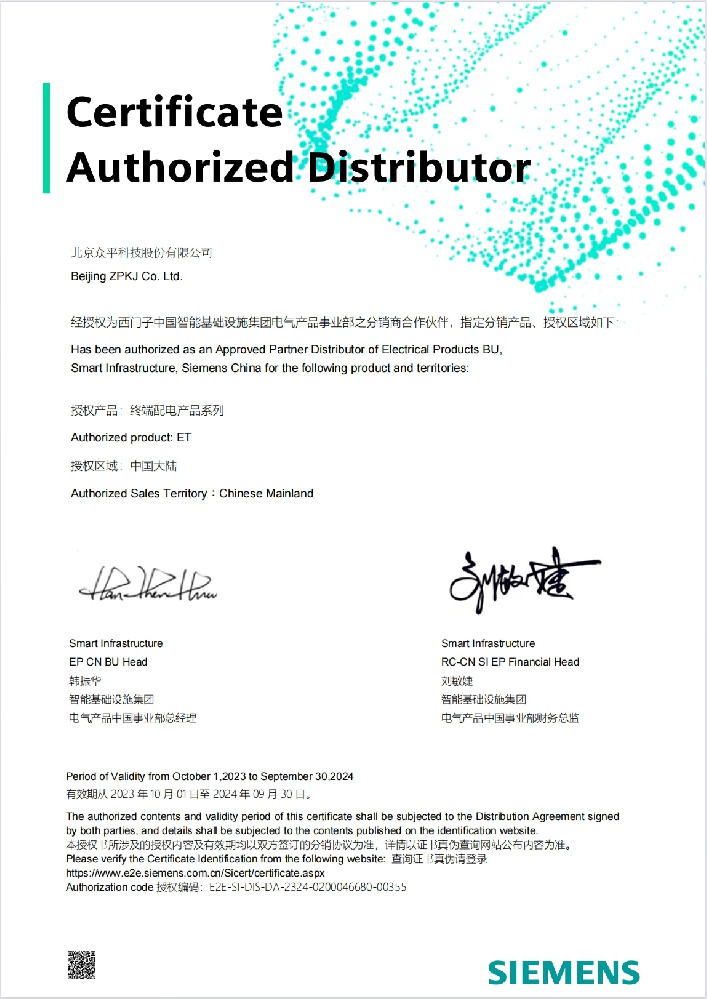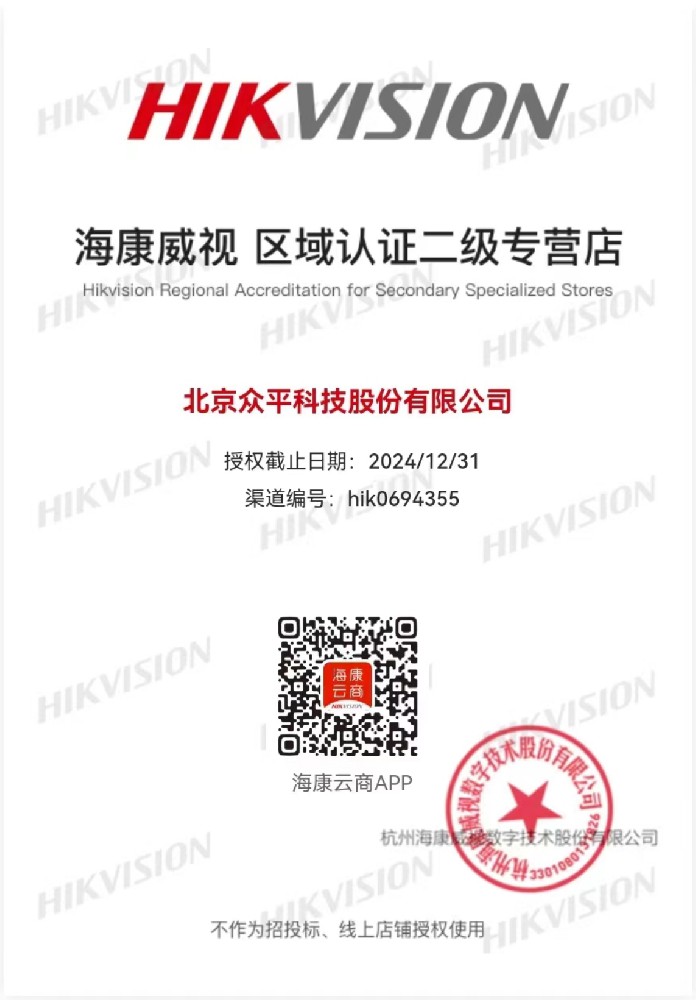The Mitsubishi Electric inverter FR-E820S-0.75K (E/SCE) is a high-performance solution in Mitsubishi automation, widely used for industrial applications. As a Mitsubishi Electric AC drive, it offers advanced control methods and reliability. This Mitsubishi Electric inverter meets diverse industrial drive needs. Below is a detailed introduction to this inverter, covering product specifications, features, applications, usage instructions, and precautions.

Product Specifications
Rated Power: 0.75kW, suitable for driving small and medium-sized motors.
Power Supply Voltage: Single-phase 200-240V, compatible with different grid voltage standards in various countries and regions.
Rated Current: 4.5A, ensuring stable operation under rated load.
Output Frequency Range: 0.2-590Hz, providing a wide speed control range to meet the speed requirements of different loads.
Control Methods: Including V/F control, sensorless vector control, and permanent magnet vector control, offering diverse control strategies to adapt to various application scenarios.
Communication Interfaces: Supporting USB and Ethernet interfaces for easy communication with PLCs, PCs, and other devices.
Protection Functions: Equipped with overload, overheat, overvoltage, and undervoltage protection functions to ensure safe operation of the equipment.
Environmental Adaptability: Capable of operating in ambient temperatures ranging from -10°C to +50°C, suitable for various harsh industrial environments.
Product Features
Sensorless Vector Control: Achieves high-precision speed and torque control, ensuring stable motor operation even without sensors.
Integrated Digital Dial and Four-Digit LED Display: Users can directly access and adjust all important parameters, monitor real-time working current values and alarm messages, and operate with ease.
Simple Wiring Design: Utilizes integrated spring clamps for quick connection of control and power lines, ensuring simplicity and reliability in wiring.
High-Performance Heat-Resistant Capacitors and Cooling Fans: Equipped with high-performance heat-resistant capacitors and cooling fans with sealed bearings to extend the inverter's lifespan.
Emergency Safety Stop Input: Compliant with EN61800-5-2 standards, providing an emergency safety stop function to ensure operator safety.
Applications
Conveyor Belt Drives: Used in logistics, packaging, food processing, and other industries to control the start, stop, and speed regulation of conveyor belts, improving production efficiency and stability.
Fans and Pump Controls: Applied in HVAC, water treatment, and chemical industries to regulate the speed of fans and pumps, achieving energy savings and reduced consumption.
Machine Tools and Drilling Machines: By precisely controlling motor speed, it enhances machining accuracy and product quality.
Doors and Door Drives: Used in construction and industrial doors to control the opening and closing speed and position of doors, ensuring smooth operation.
Usage Instructions
Installation and Wiring
Installation Environment: Choose a dust-free, non-corrosive gas-free, and low electromagnetic interference environment with good heat dissipation.
Wiring Requirements: Follow the wiring diagram in the product manual to ensure correct connections of power, signal, and motor lines.
Grounding Protection: Ensure proper grounding of the equipment in compliance with national and local electrical safety standards.
Parameter Settings
Basic Parameter Settings: Including motor parameters, control methods, and frequency range, set according to actual application needs.
Advanced Function Configuration: Such as PID control and multi-speed control, configure based on specific application scenarios to achieve more complex control functions.
Maintenance and Inspection
Regular Inspection: Check for any damage to the inverter's appearance, dust accumulation on heat sinks, and proper fan operation. Clean the dust from heat sinks and fans regularly to ensure unobstructed heat dissipation.
Parameter Verification: Regularly verify the inverter's parameter settings to ensure they align with actual application needs.
Fault Diagnosis: When a fault occurs, promptly check the fault code and refer to the troubleshooting guide in the manual for diagnosis and resolution.
Precautions
Environmental Conditions: Avoid using the product in high-temperature, high-humidity, or high electromagnetic interference environments to prevent performance degradation and reduced lifespan.
Power Supply Requirements: Ensure stable power supply voltage to avoid damage to the inverter due to voltage fluctuations. Wait for a certain period before re-powering the device after a power cut to prevent damage.
Safe Operation: Avoid contact with live parts during operation to ensure operator safety. Disconnect power and wait for capacitor discharge to complete before performing maintenance and inspection.
Frequently Asked Questions and Answers
1. How to Perform Motor Autotuning on the Mitsubishi Electric Inverter?
Importance of Motor Autotuning: Autotuning is essential for ensuring compatibility between the Mitsubishi Electric inverter and the motor, improving control accuracy and system stability. It involves setting motor parameters such as power, rated voltage, and rated current.
Precautions During Autotuning: Ensure the motor is properly connected and stationary before starting autotuning. During the process, the Mitsubishi Electric AC drive injects current into the motor, so the system should be in a ready state.
Effects of Autotuning: The inverter automatically adjusts control parameters based on motor characteristics, enhancing system response speed and control precision.
2. How to Configure the Communication Interface of the Inverter?
Communication Interface Types: The Mitsubishi automation inverter supports USB and Ethernet interfaces for flexible integration.
Communication Line Connection: Use shielded cables to minimize electromagnetic interference and ensure proper grounding for stable data transmission.
Communication Parameter Settings: Configure the inverter’s address, baud rate, data bits, and stop bits according to the system requirements, ensuring compatibility with the PLC or upper-level controller.
3. How to Select the Power Range for the Mitsubishi Electric Inverter?
Select Based on Load Requirements: Choose the Mitsubishi Electric inverter based on the motor's actual load. Light loads can use an inverter matching the motor's rated power, while heavy loads may require a higher-power model.
Consider Safety Margin: A slightly higher power rating ensures the inverter can handle load variations and unexpected spikes.
Overload Capacity: The Mitsubishi Electric AC drive has short-term overload capacity, but prolonged overloading should be avoided to maintain performance and lifespan.
4. What Cooling Method is Used by the Mitsubishi Electric Inverter?
Cooling Method: The Mitsubishi Electric inverter uses forced air cooling with an internal cooling fan.
Installation Requirements: Ensure sufficient ventilation and avoid placing the inverter in enclosed or poorly ventilated areas.
Maintenance: Regularly clean dust from fans and heat sinks to prevent overheating and ensure stable operation.
5. How to Avoid Electromagnetic Interference in Mitsubishi Inverters?
Built-in Filters: The Mitsubishi automation inverter includes an EMC filter to suppress electromagnetic interference.
Wiring Precautions: Keep signal lines separate from power lines and use shielded cables for signal transmission.
Grounding Measures: Ensure proper grounding in compliance with local electrical safety standards to reduce interference and enhance system stability.
6. What Protection Functions Does the Mitsubishi Electric Inverter Offer?
Overload Protection: If the motor load exceeds the rated value, the Mitsubishi Electric AC drive automatically adjusts frequency or stops operation to prevent damage.
Overheat Protection: An internal temperature sensor shuts down the inverter if the temperature exceeds safe limits.
Overvoltage and Undervoltage Protection: The inverter prevents damage by shutting down when voltage levels are too high or too low. It also includes short-circuit and phase-loss protection.
7. How to Perform Regular Maintenance on the Mitsubishi Electric Inverter?
Visual Inspection: Regularly check for exterior damage, loose screws, or cracks.
Cooling System Maintenance: Clean dust from heat sinks and fans to maintain effective cooling.
Electrical Connection Inspection: Ensure secure wiring and check for any loose connections.
8. What Should Be Considered When Installing the Mitsubishi Electric Inverter?
Installation Location: Choose a dust-free, well-ventilated, and stable environment free from corrosive gases and strong electromagnetic fields.
Installation Method: The Mitsubishi automation inverter should be mounted vertically to optimize heat dissipation.
Power Connection: Ensure correct phase sequence, proper cable sizing, and effective grounding for safe operation.
9. How to Choose the Control Mode for the Mitsubishi Electric Inverter?
Select Based on Application Needs: For applications requiring precise speed control, sensorless vector control is ideal. For simpler constant-speed applications, V/F control is a better choice.
Control Mode Features: Sensorless vector control provides high-precision speed and torque control, making it suitable for Mitsubishi automation applications requiring precise motor performance. V/F control offers ease of use and reliability for general operations.
Parameter Settings: Configure the control parameters based on the selected mode to ensure optimal performance.
10. How to Set the Frequency Setting Channel on the FR-E820S-0.75K (E/SCE) Inverter?
Frequency Setting Methods: The FR-E820S-0.75K (E/SCE) inverter allows frequency settings through the control panel, external analog signals, or digital signals.
Signal Source Requirements: When using external signals, ensure signal stability and proper shielding to prevent interference.
Parameter Configuration: Adjust the parameters according to the selected input method, ensuring accurate and responsive frequency control.
FAQ
1.Who are We?
Beijing Zhongping Technology Co., LTD., is a one-stop integrated service provider of intelligent manufacturing, belongs to the Gong Doctor Group, is a scientific research, design, marketing, technical services, industrial Internet, international import and export services as one of the science and technology companies.
2.What can you buy from us?
PLC, inverter, human-machine interface, hydraulic products, low-voltage power distribution, industrial robots and core components
3.Is the item in stock or need to be purchased from another supplier?
We have a large inventory of goods and have our own warehouse.
4.What advantages do we have over other suppliers?
Our company has a large amount of inventory and a number of warehouses, but also in the country's important industrial provinces and cities with offices and a number of overseas service points. To provide you with intelligent manufacturing one-stop comprehensive services, save efforts, labor and cost.
5.Can you provide 100% new original authentic products?
We only sell new original genuine, no renovation, no fake, only for the original factory original!
6.How long is the delivery time?
If there is a stock, it will take 2-3 working days to ship, if the quantity is large, it will take 5-7 working days after receiving the payment, if it is not a conventional model, it will take some time, we will inform you of the specific delivery time.
7.Is there technical support available?
Of course, we have a professional technical team that can help you solve technical problems.
8.How do we guarantee quality?
We have three processes to control the quality of goods.
1). Our engineers will inspect the production and quality control in the factory regularly.
2) Incoming materials shall be inspected by experienced purchasing engineers before they can be stored.
3). At least 2 people in the logistics department cross-check the goods to be sent before delivery.
9.Can you guarantee the safe and reliable delivery of your products?
Yes, we strictly adopt the international standard packing. We also use special packaging for dangerous goods, and refrigerated shipping for items with temperature requirements. Special item packaging and general cargo standard packaging requirements may incur additional costs.
10.How about the freight?
The cost depends on how you choose to get the goods. Express is usually the fastest but also the most expensive way. Sea freight is the best solution for large quantities of goods. The exact shipping cost depends on the purchase amount、quantity and weight of your order. Please feel free to contact us for more information.


 010-64225983
010-64225983 +8613811814778
+8613811814778 info@zhongpingtech.com
info@zhongpingtech.com Building 26, Liyuan Community, Chaoyang District, Beijing, China
Building 26, Liyuan Community, Chaoyang District, Beijing, China






